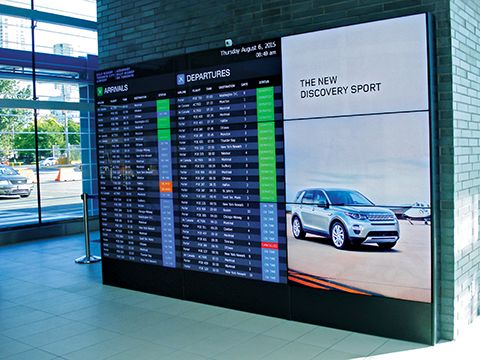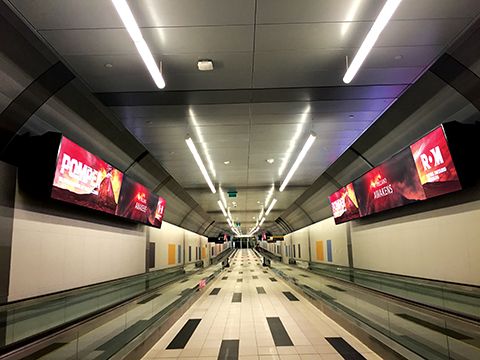By Peter Saunders
When PortsToronto planned a 260-m (853-ft) long pedestrian tunnel under Lake Ontario’s Western Channel to Billy Bishop Toronto City Airport (BBTCA), which it owns and operates on Toronto Island, the agency of Transport Canada recognized an opportunity to help fund the public-private partnership (P3) project by earning new revenue through digital out-of-home (DOOH) advertising. Brand marketers would be offered the chance to specifically target a customer base of frequent, short-term business travellers at Canada’s ninth busiest airport, who already benefited from ease of downtown access to the island—compared to getting to and from the much larger Pearson International Airport at the outskirts of the city—but now also would be able to walk there in less than six minutes, instead of waiting for a short ferry ride across the channel.
Early planning
The tunnel was announced and began to be excavated in 2012. To use it, departing travellers would descend 30.5 m (100 ft) by elevator on the mainland side, cross the main passageway using any of four moving walkways and finally ascend via escalator or elevator on the island side to BBTCA’s Porter Airlines and Air Canada check-in areas.
With the excavations underway, PortsToronto—then known as the Toronto Port Authority (TPA)—began planning a digital signage network and a corresponding mobile app with local advertising firm Black.

The first indoor video wall visitors see features flight arrival and departure listings with advertisements.
“We’re a media company that started out as an ad agency, but we’ve since pivoted to the digital out-of-home (DOOH) industry, because we feel traditional out-of-home (OOH) signage isn’t the right medium for today,” says president and CEO Dean Black, who founded Black in 1992. “Digital signage offers advertisers a better ability to deliver their messages. With dayparting, for example, it becomes easier for smaller advertisers to get their messages out by buying smaller slots of time, while larger advertisers can also benefit by tailoring messages to a certain time of day, the weather and other variables.”
In the case of BBTCA, PortsToronto would own the digital assets, with Black overseeing content creation, ad sales and interactive planning. And while Black would develop the mobile app, PortsToronto would own the rights to its use and licensing.
“Larger companies like Pattison Outdoor Advertising, Astral Out-of-Home or Clear Channel Outdoor have vast networks to sell, but we keep a lower profile as consultants,” says Black. “In this case, we work for the airport’s landlord.”
For PortsToronto, it was an opportunity to use screen-to-screen content movement technology for wayfinding, passenger tracking, information delivery, flow management, entertainment and interactivity.
“We do not receive government funding,” explains Geoffrey A. Wilson, CEO of PortsToronto. “We are mandated to be self-sustaining. So, it is important we identify opportunities to generate revenue that will finance our ongoing operations and fund improvements to the airport.”






